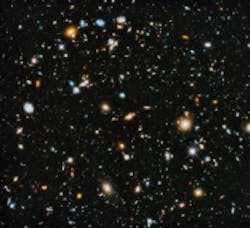NASA has released a color composite image taken years with two of the Hubble telescope’s camera systems that shows approximately 10,000 galaxies and extends back in time to within a few hundred million years of the big bang.
The impressive new image was created from images captured by the Hubble’s Advanced Camera for Surveys (ACS) and Wide Field Camera 3 (WFC3) from 2003 to 2012. The WFC3 system features an ultraviolet and visible light and infrared channel. A channel select mechanism directs incoming light to the desired channel:
- The IR channel features a Teledyne Imaging Sensor 1Kx1K HgCdTe detector with, a 0.13 arcsecond pixel size, and a total field of view of 123 x 136 arcseconds.
- The UVIS channel features two e2V thinned, backside illuminated, UV-optimized 2Kx4K CCD image sensors with 0.04 arcsecond pixel size and a total field of view of 162 x 162 arcseconds.
The ACS system features two active channels, each of which are optimized for specific scientific tasks: The wide field channel (WFC) and solar blind channel. The WFC is a high throughput, optical and near infrared camera that features two 2048 x 4096 CCD detectors from Scientific Imaging Technologies with a 15 µm x 15 µm pixel size. The WFC camera features a 202” x 202” FOV and a 350-1050 nm spectral response.
Also used to capture images on the ACS was the solar blind channel, which features a 1024 x 1024 multi-anode microchannel detector array with a 25 µm x 25 µm pixel size and 115-180 nm spectral response.
Astronomers had previously studied the Hubble Ultra Deep Field in visible and NIR light in a series of images captured from 2003 to 2009. Now, using UV light, astronomers have combined the full range of colors available to Hubble, from UV to NIR light, resulting in an image made from 841 orbits of telescope viewing time that contains approximately 10,000 galaxies and extends back in time to within a few hundred million years of the big bang. Studying images such as these enables astronomers to understand how galaxies grew in size by forming small collections of very hot stars, according to NASA.
View the press release and images.
Also check out:
Curiosity Rover captures striking image of Mars’ Mount Sharp
Telescopes help identify first ring system around minor planet
Images captured by Cassini spacecraft may show ocean waves on Titan
Share your vision-related news by contacting James Carroll, Senior Web Editor, Vision Systems Design
To receive news like this in your inbox, click here.
Join our LinkedIn group | Like us on Facebook | Follow us on Twitter | Check us out on Google +
About the Author

James Carroll
Former VSD Editor James Carroll joined the team 2013. Carroll covered machine vision and imaging from numerous angles, including application stories, industry news, market updates, and new products. In addition to writing and editing articles, Carroll managed the Innovators Awards program and webcasts.
